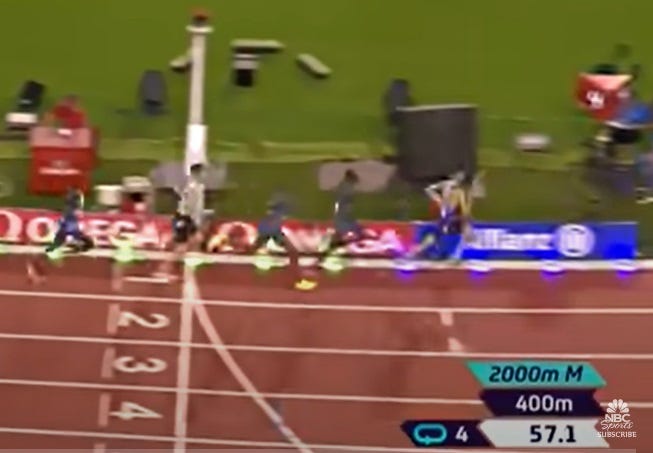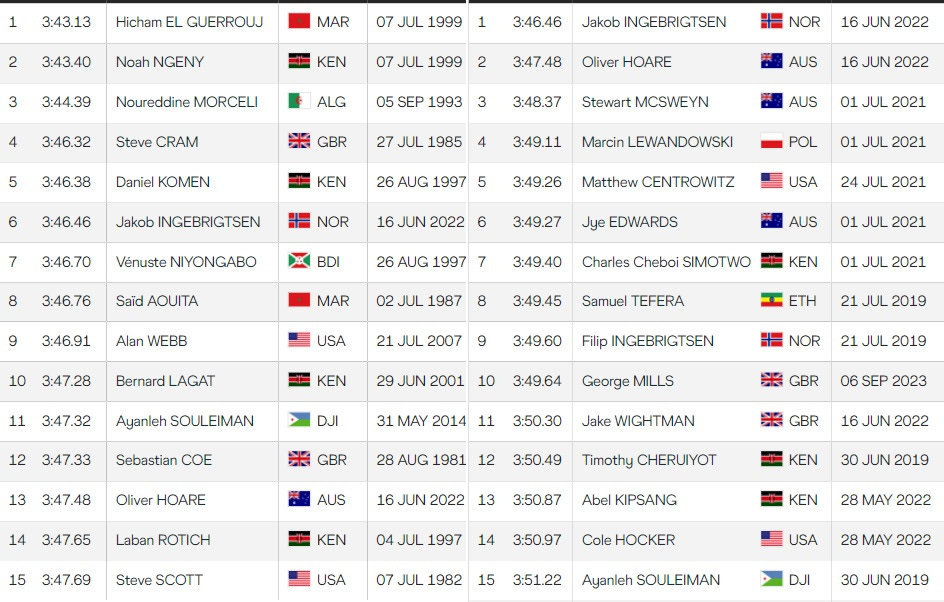Jakob Ingebrigtsen, though necessarily something of a punk, will probably break at least two more and as many as four more outdoor world records
We actually learned a great deal from this 4:43.13
On Friday at the Memorial van Damme Diamond League meeting in Bruxelles1, the penultimate gathering of the 2023 DL series, Jakob Ingebrigtsen demolished Hicham El Guerrouj’s 24-year-old world record for 2,000 meters in a stunning time of 4:43.13 (meet results).
In 1999, El Guerrouj ran 4:44.79 for five laps in Berlin exactly two months after setting a still-standing world record in the one mile (3:43.13). Going into Friday’s race, the Moroccan was the only man to have ever averaged under 57 seconds per lap for five laps, and one of only two men to have managed “even” a sub-57.5-second average. Ingebrigtsen saw El G’s 56.96 and not only raised it to 56.63 but did so with non-trivially negative splits (2:22.28/2:20.85).
The 22-year-old Ingebrigtsen—who was around six months of age when wunderkind-of-his-time Alan Webb banged out a 3:53.43 at the 2001 Prefontaine Classic to break Jim Ryun’s American high-school record—has already won five medals at global championships (three gold and two silver) and broke Daniel Kipngetich Komen’s world best for two miles.
And yeah, fuckin’ World Athletics considers the fastest-ever 2,000-meter time a “world record,” but the fastest-ever two mile time a “world best.”
As for Ingebrigtsen reporting having been “under par” when Josh Kerr steamrolled his pasty white ass in the homestretch of the 1,500-meter final at the recent 2023 World Athletics Championships in Budapest, he comes off as a punk. This is true whether or not the claim itself is true. It’s reminiscent of Ingebrigtsen posting his positive covid-19 test result for the world to see after Samuel Tefera whipped that boy but good at the same distance a year and a half ago at the 2022 World Indoor Athletics Championships in Београд, wherever the hell that is. He did this despite being aware that everyone knew by this time that covid-19 makes everyone extremely ill and that Ingebrigtsen therefore would have passed out and died during the race had he really been infected. It bears mentioning that he’s surely used to bragging about sham lab-test results of all kinds by now.
In all seriousness, Ingebrigtsen was probably telling the truth. Both times. For one thing, he reached a point of fitness prior to this year’s Worlds that made barely breaking 3:30 a legitimately poor race, considering he never chokes or paces himself remotely poorly. For another, well, look what he just did.
That the 2,000 meters is rarely contested does not reduce the impact of Ingebrigtsen’s time. It just means that the list of the all-time best performers in the event has a greater-than-usual spread between names. And there are some studly names on it besides El Guerrouj’s. Algerian Ali Saidi-Sief, now #3 all-time (4:46.88), was a 3:29.51/7:25.02/12:50.96 guy at the turn of the century. He also served a two-year suspension after testing positive for nandrolone2 at the 2001 World Athletics Championships, resulting in the loss of the silver 5,000-meter medal he’d collected in Edmonton.
The all-time #4 man at 4:47.88, Noureddine Morceli, was the mile world-record-holder by almost two seconds before El Guerrouj wandered along (3:44.39) as well as Algerian well before Saidi-Sief was born.
One way to hammer home how fast 4:43.13 is for five laps is to consider how stellar a 1,600-meter time this is for U.S. high-school girls. Yes, that punk Ingebrigtsen could beat almost every girl in the country is given a full one-lap handicap.
A better way is to point out that Ingebrigtsen covered his final four laps in around 3:46.0. The World Athletics results page doesn’t include splits, but a frame capture of the above-embedded NBC Sports video suggests that Ingebrigtsen reached the 400-meter mark in very close to 57.1 seconds.
Ingebrigtsen therefore completed his last mile (1,609.344 meters) in about 3:47.32. While a running start actually counts for a lot even in the mile at the world-class level (16 miles an hour is a sprint for practically everyone alive who can ever reach this speed), it’s still amazing that this time would nearly land Ingebrigtsen among the top ten all-time outdoor performers for the mile, including himself.
Perhaps even more noteworthy is that only Ingebrigtsen himself has run faster than 3:47.32 since the advent of Nike’s ZoomX racing-spike-plate technology in 2019. I know that athletes had them on their feet in significant numbers for the first time at the 2019 World Athletics Championships in Doha, but the right-hand column below includes all performances from the start of 2019 onward just to be “sure.”
I’m tempted to cut Ingebrigtsen some slack for repeatedly disclosing evidence of having been less than 100 percent following losses, because the guy is as close to a pure machine as you’ll find. He seems perfectly happy with what he’s doing with his life even though he didn’t choose it, but he’s known little besides but training to be the best distance runner the world has ever seen for around ten years. Everything he puts into his body, or any information gleaned from its contents by lab tests or other forms of technology, is processed through the lens of “How will this help me?”
So when he complains of having been ill, this may not be the workaday excuse-forging it sounds like. Ingebrigtsen may be even more used to viewing himself as a machine than other runners of his caliber. He’s just giving a systems update with these disclosures. Besides, people do ask him a lot of questions about his running, with his answers then ejected into the public for review and subsequent panning.
“Other runners of his caliber” is a tiny and apparently still-shrinking club. Ingebrigtsen is clearly capable of breaking Komen’s musty 3,000-meter world record (7:20.67) and Joshua Cheptegei’s three-year-old 5,000-meter world record (12:35.36). But despite the 2,000 meters obviously being closer in distance to the 1,500 meters and the mile than to either of these events, Ingebrigtsen will need to at least replicate the raw-output shazam of his van Damme effort to claim either of El Guerrouj’s two remaining world records. 3:26.00 is a long way from 3:27.14 (Ingebrigtsen’s best so far) and 3:43.13 is almost as good in absolute terms.
Maybe a better way to express this is that Ingebrigtsen will probably spend one or two more seasons going after those records before committing himself more fully to the 5,000 meters, as he seems to understand that he’s as good as he is at the 1,500 meters and mile because he is an aerobic monster who could probably run 26:40 for 10,000 meters right now, or soon, unless he has covid again. He should probably avoid Athing Mu, who’s had the disease as often as not since its much-panned winter 2020 release.
And since you asked, of course I think Ingebrigtsen is on the same drugs everyone else is. He would have to be a moron to devote his life to breaking world records and “doing it the right way.” Drugs are not just the best way, they’re the only game in town for people at the world-class level (and I don’t mean 3:35). When Jakob started getting even more attention than his two older brothers and their porn-’stache faces, this naturally created a renewed focus on “the Norwegian method” involving blood-lactate monitoring popularized by Marius Bakken at the turn of the century. If this was supposed to explain Jakob’s success, then does it also explain why Norwegians in comparison did next to nothing in the 20 years between Bakken first publicizing his work and methods and Jakob’s coronation as one of the best in the world across a range of distances?
The usual barely related postscript: Seeing the name of the #7 all-time miler, Venuste Niyongabo, for the first time in a while reminded me of how underappreciated this man is. I doubt many people can remember off the tops of their heads that the Burundian won the 5,000-meter gold medal at the 1996 Summer Olympics in Atlanta.
When Niyongabo, now a legitimate peace activist, ran that 3:46.70 in August 1997, it was and remains the fastest third-place time in history. Niyongabo wound up in a fight that evening with El Guerrouj—who had missed Morceli’s world record the previous month by 0.61 seconds with a personal-best mile time of 3:44.90—and Komen.
We might as well let the French hang on to something.
Jerry Schumacher, who famously told the world two years ago that he’d never heard of nandrolone, was then over several seasons into coaching at his alma mater, the University of Wisconsin. The idea that Schumacher—who belatedly revealed that his most celebrated athlete, Shelby Houlihan, was in the cooler for four years owing to enormous trace amounts of nandrolone having been found in Houlihan’s urine, at least some of it—didn’t register the suspension of Saidi-Sief, the silver medalist in the 5,000-meters at the 2000 Summer Olympics in Sydney, in real time is as idiotic as the rest of the bullshit that started flowing from the Bowerman Track Club two summers ago and has never really stopped.




